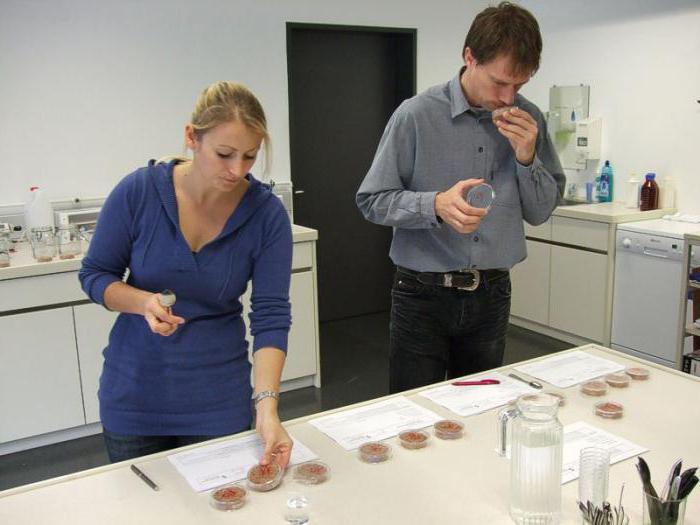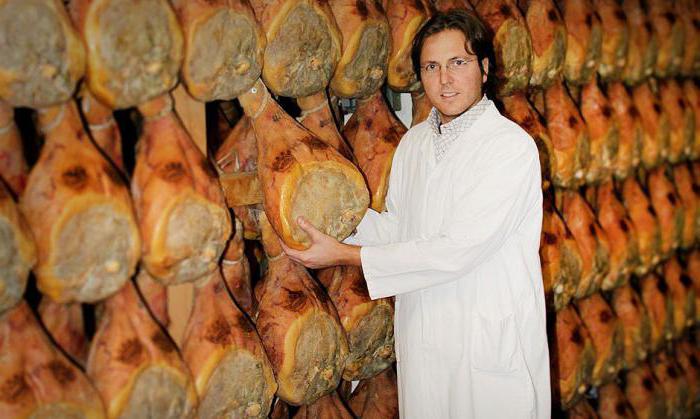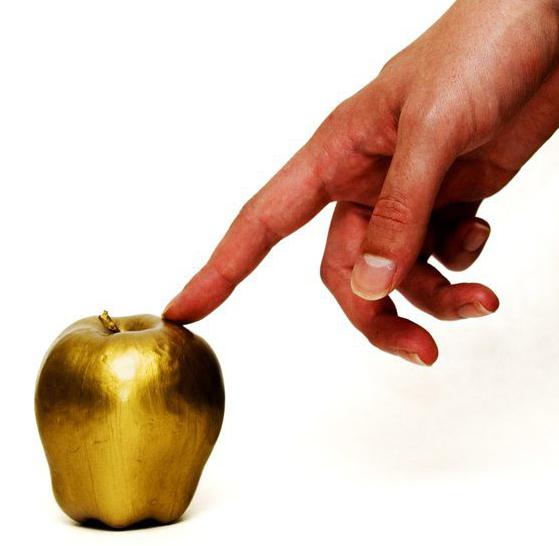Organoleptic methods are extremely simple and always used in the first place, which eliminates the need for other measuring methods because of their cost, as well as time consuming. In addition to accessibility and ease, this method is also indispensable in assessing quality indicators.
What it is?
Organoleptic research methods are the determination of the quality of a product using standard human senses, that is, visual, olfactory, tactile, taste, and sometimes even auditory.  At the same time, it is worth noting the fact that quite often the method of carrying out organoleptic research is usually called tasting. But this is not true, since it is only a sample of a certain product to taste, and in the case of using the organoleptic method, a variety of organs participate in the process.
At the same time, it is worth noting the fact that quite often the method of carrying out organoleptic research is usually called tasting. But this is not true, since it is only a sample of a certain product to taste, and in the case of using the organoleptic method, a variety of organs participate in the process.
For certain food products (in particular, wine), organoleptic methods are important in assessing quality, since in this case special attention is paid to taste and aroma. Standard laboratory methods do not allow the determination of small quantities of product chemicals, which together create a rather complex taste and aroma.
To provide quick control quality of goods especially when it comes to terms of trade, organoleptic methods play an extremely important role. Indeed, the main advantage of this research option is simplicity, as well as the fact that it is available to absolutely everyone.
If we talk about what are the shortcomings of organoleptic methods, it is worth noting that, in fact, they are quite subjective. However, by creating certain conditions during the analysis, the overall subjectivity of the assessment is minimized.
In what cases is this method used?
The organoleptic method for assessing the quality of goods is used in the following cases:
- in order to detect differences between commercial products or several batches of the same product;
- to ensure control over the quality of products during their production;
- in order to assess the quality factor of goods sold in trade.
The basics
When using the organoleptic method of assessing the quality of goods, a wide variety of human senses take part. In particular, the importance of the organs of smell, vision, and taste is noted, and the organs of hearing and touch play a relatively small role.
 The sense organs are rather complex systems that are not limited only to what is visible from the outside, that is, the nose, eyes and tongue. It is for this reason that it will be more correct to say that the organoleptic research method involves the use of the so-called analyzer, which includes three main elements:
The sense organs are rather complex systems that are not limited only to what is visible from the outside, that is, the nose, eyes and tongue. It is for this reason that it will be more correct to say that the organoleptic research method involves the use of the so-called analyzer, which includes three main elements:
- The organ itself.
- The pathway through which perceived irritation is transmitted.
- A certain part of the cerebral cortex, to which irritation comes in and where the final formation of certain sensations takes place.
Appearance
The organoleptic method of research begins with an external examination, that is, with the use of visual sensation.Such an inspection is usually called visual, since it is carried out with the naked eye. In this case, the organoleptic method of quality assessment involves determining the nature of the packaging, the shape and consistency of the product, as well as its color, turbidity or transparency.
 It should be understood that it is difficult to accurately determine the color, because the color scheme provides a certain number of different shades. Thus, if daylight falls on an object, and more than 90% of its amount is reflected, the body will appear white. Thus, refined sugar, granulated sugar and table salt appear white to the observer, despite the fact that salt and sugar crystals are transparent in nature.
It should be understood that it is difficult to accurately determine the color, because the color scheme provides a certain number of different shades. Thus, if daylight falls on an object, and more than 90% of its amount is reflected, the body will appear white. Thus, refined sugar, granulated sugar and table salt appear white to the observer, despite the fact that salt and sugar crystals are transparent in nature.
If the body absorbs a certain part of the rays of visible light, while the remaining rays are reflected from its surface, then it is considered colored, and the color of the object is directly determined by the shade of the rays reflected by it. Thus, red wine is able to absorb any rays other than red, as a result of which we perceive it as a red substance.
In most cases, the organoleptic method for determining the quality of goods involves the use of various standards (for example, roasted coffee), as well as a color scale or specialized prescriptions.
In the process of determining the color of commercial products, a sufficiently large number of conditions must be taken into account, due to which a normal visual perception of the subject is ensured. First of all, it is necessary to ensure uniform illumination, since in low light the perception will be inaccurate, and too bright light will eventually tire your eyes, which will also negatively affect the result of the assessment.
State standards
Organoleptic research methods are necessarily based on the prescribed and approved GOST standards. Thus, according to state standards in the process of checking meat is established:
- consistency;
- smell;
- color and appearance;
- tendon condition;
- fat condition;
- transparency and aroma of the broth.
Only after examination of all these parameters can taste testing be carried out, but if this testing proves to be a failure for the product, it can be rejected.
State norms and standards are established for all groups of goods: both food and non-food. For example, when studying the quality of perfumes using organoleptic methods, experts pay attention to the following parameters:
- smell;
- its quality and durability;
- color and transparency of the liquid;
- the appearance of the product and its design.

Taste
Taste sensations play a paramount role. Indeed, quite often there are situations when even with the full compliance of the physicochemical parameters of a certain product with GOST requirements, organoleptic methods determine it as defective, since it has an unsatisfactory taste.
The main are four types of taste - salty, sweet, bitter and sour. On different parts of the surface of the tongue are the so-called taste buds. The tip of the tongue is the most sensitive to salty and sweet substances, since it contains bulbs that respond specifically to these types of tastes.
At the base of the tongue, the bulbs are adapted to perceive a bitter taste, while at the edges of the back of the tongue, acidic foods are most recognized.
The organoleptic method of quality research provides a sense of taste only if the tested substance is in water or saliva, that is, in a dissolved state. At the same time, each taste provides an appropriate reaction if there is a minimum concentration of a substance called the threshold of sensation.
Smell
No less important influence on determining the quality of various food products is their smell. The nasal cavity directly communicates with the oral cavity, as a result of which the olfactory sensation can merge with the taste. This physiological feature must be taken into account when using the organoleptic method of researching the quality of goods. Just like taste, the smell directly depends on certain chemicals, which are most often volatile and come into contact with the nerve epithelium located in the upper part of the nasal cavity. In general, the surface of the epithelium does not exceed 5 cm2.
The total number of distinguishable odors is quite large, and the final classification of aromas has not been developed to date. So far, it is customary to distinguish only seven main groups:
- musky;
- camphor;
- mint;
- floral;
- acute;
- ethereal;
- putrefactive.
The remaining odors that exist in nature and, accordingly, in food products are considered from the point of view of a combination of several of the above groups.
Touch
Organoleptic methods for evaluating the product also include tactile sensations, which are required to determine the physical structure and consistency of the product, as well as to recognize its temperature, degree of grinding, and a number of other physical properties.
 Tactile analyzers are mainly located at the fingertips, tongue and gums.
Tactile analyzers are mainly located at the fingertips, tongue and gums.
The idea of the consistency of the substance at the moment, as well as determining the approximate size of the particles of granular or powdery products, use your fingertips. It is in this way that it is customary to determine the degree of grinding in the process of ensuring quality control of flour, the elasticity of chilled meat and a host of other parameters.
The organoleptic method in some cases provides an idea of the consistency of a particular product. This occurs due to visual sensations in the process of mixing the mass of the product or cutting it. Thus, by transfusion of fluid and observation of the procedure for its flow, you can approximately understand how viscous it is. The same applies to the flowability of powdered and granular products.
If we talk about the plasticity or hardness of the substance, then in this case tactile organoleptic methods of quality control should be applied, that is, pressure on the product with a spatula or cutting with a knife. The idea of the consistency of the product, as well as its juiciness or fragility, can be made during biting and chewing the sample, while the temperature of the product is determined by the tip of the tongue during the testing of the substance for taste.
Sound
The organoleptic method of evaluating goods gives auditory sensations a secondary importance. But in the process of tasting when biting products such as apples, cucumbers, crackers and a variety of confectionery products, auditory sensations arising from the crunch can be taken into account.
 They are perceived by an ordinary person as subconsciously combining with taste feelings, that is, enhance and emphasize them.
They are perceived by an ordinary person as subconsciously combining with taste feelings, that is, enhance and emphasize them.
Auditory sensations acquire independent significance only if the quality of champagne or watermelons is determined by the organoleptic method. In the first case, the degree of saturation of wine with carbon dioxide is determined in the process of uncorking the bottle, and in the second, the maturity of the product is determined by tapping it.
Taste Dignity
From all the above, we can conclude that the taste in the process of tasting food products cannot coincide only with the physical term. This concept is broader because it takes into account not only the taste sensations themselves, but also the data added to them from the organs of smell, touch or sight.It is for this reason that in the process of assessing the taste of any food products and, in principle, any food, the concept of “taste advantage” can be arbitrarily used.
Taste dignity is formed from a number of sensations that arise in the process of exposure to taste, smell, touch, and in some cases sound. For products such as tea, wine, cheese and many others, it is customary to replace a similar term with the term “bouquet”, which means a complex combination of smell and taste of a tasted product.
Point system
Through the use of a point system for evaluating food products, the results of organoleptic research acquire a quantitative expression, which is established by a certain number of conditional evaluation units. Depending on the quality level of a particular product, they are assigned higher or lower rating points in the limit provided by the system established for the product. Unfortunately, at the moment, full-fledged scoring systems are developed only for a limited list of commercial products, but over time this list will expand more and more.
 Among other things, it is worth noting such varieties of the organoleptic method as tasting, sensory and others. Touch is used to evaluate the quality of food. In particular, this method determines the color, smell, taste, as well as the consistency of food products.
Among other things, it is worth noting such varieties of the organoleptic method as tasting, sensory and others. Touch is used to evaluate the quality of food. In particular, this method determines the color, smell, taste, as well as the consistency of food products.
The tasting method involves testing the food items. In this case, the results obtained will depend on the qualifications of the expert, as well as compliance with the main conditions of the tasting. In particular, a person should not smoke before using this procedure, nor use any odorous substances, including perfumes.
Despite the fact that the organoleptic method has a number of obvious advantages, it also has certain disadvantages. Its main disadvantage is subjectivity, because the reliability of quality indicators directly depends on qualifications, skills, abilities, as well as the individual characteristics of those people who determine the parameters of products.
Chemicals and their effects on sample results
Indicators of chemical composition can perform various functions and serve as identifying signs of quality accessories. For example, a large mass fraction of sucrose is characteristic of various sugar confectionery, and a certain amount of caffeine is found in natural coffee.
Any goods, regardless of their purpose, are a combination of certain substances. The differences between certain products are determined by the set of components present in them, as well as their ratio. Thus, all food products, as well as most non-food products, include water and various dry substances, the ratio of which sometimes changes. The so-called dry foods, a large number of non-food items include the dry matter content, and they contain extremely little water.
The chemical properties of goods are determined not only by the composition, but also by the ability to form some kind of consumer properties. For example, sugar, salt, acid, as well as other flavors directly affect the taste, while dyes affect the color. The whole variety of chemicals of various products existing today can be divided into several groups, subgroups and types, depending on their nature.
The chemical properties of materials and products are determined by their reaction to exposure to all kinds of substances or the environment.Also, the mode of technological processing of materials or finished products, as well as the period of their service and implementation, directly depends on this.
The chemical composition and internal structure allows us to understand the properties of this substance. In particular, they are formed in the process of technological processing. There is a logical chain, including:
- Chemical composition.
- Technology.
- Structure.
- Product properties.
This relationship of composition and its structure with the final properties of finished products and factors that affect the quality of products is constantly being studied by materials science and technology.
Thus, there are many features of using organoleptic research methods, and each has its own subtleties.






